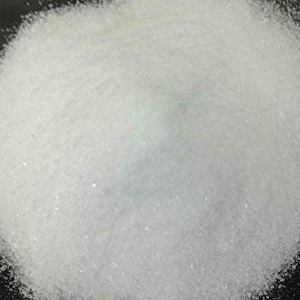
Sorbic acid, or 2,4-hexadienoic acid, is used as a food preservative. It has the chemical formula CH3(CH)4CO2H. It is a colourless solid that is slightly soluble in water and sublimes readily. The E numbers is E200 for Sorbic acid.
We offer both plain and encapsulated sorbic acid
C6H8O2 112.13
2,4-Hexadienoic acid, (E,E)-; 2,4-Hexadienoic acid.
(E,E)-Sorbic acid; Sorbic acid [110-44-1].
Sorbic Acid contains not less than 99.0 percent and not more than 101.0 percent of C6H8O2, calculated on the anhydrous basis.
Identification:
A: To a solution of 200 mg in 2 mL of alcohol add a few drops of bromine: the color is discharged.
B: A 1 in 400,000 solution in isopropyl alcohol exhibits an absorbance maximum at 254 ± 2 nm.
Melting range: between 132 and 135 .
Water, Method: not more than 0.5%.
Residue on ignition: not more than 0.2%.
Heavy metals, Method: 0.001%.
Assay: Dissolve about 250 mg of Sorbic Acid, accurately weighed, in a mixture of 50 mL of methanol and 25 mL of water that previously has been neutralized with 0.02 N sodium hydroxide. Add PhPh and titrate with 0.1 N sodium hydroxide to the first pink color that persists for at least 30 seconds. Each mL of 0.1 N sodium hydroxide is equivalent to 11.21 mg of C6H8O2.
Ph Eur
C6H8O2 --- 112.1 --- 22500-92-1
Action and use: Antimicrobial preservative.
DEFINITION
(E,E)-Hexa-2,4-dienoic acid.
Content: 99.0 per cent to 101.0 per cent (anhydrous substance).
CHARACTERS
Appearance: White or almost white, crystalline powder.
Solubility: Slightly soluble in water, freely soluble in ethanol (96 per cent).
IDENTIFICATION
First identification A, C.
Second identification A, B, D.
A. Melting point: 132 °C to 136 °C.
B. Ultraviolet and visible absorption spectrophotometry.
C. Infrared absorption spectrophotometry.
D. Dissolve 0.2 g in 2 mL of ethanol (96 per cent) and add 0.2 mL of bromine water. The solution is decolorised.
TESTS
Solution S: Dissolve 1.25 g in ethanol (96 per cent) and dilute to 25 mL with the same solvent.
Appearance of solution: Solution S is clear and colourless.
Aldehydes: Maximum 0.15 per cent, calculated as C2H4O.
Heavy metals: Maximum 10 ppm.
Water: Maximum 1.0 per cent, determined on 2.000 g.
Sulfated ash: Maximum 0.2 per cent, determined on 1.0 g.
ASSAY: Dissolve 0.1000 g in 20 mL of ethanol (96 per cent). Using 0.2 mL of PhPh solution as indicator, titrate with 0.1 M sodium hydroxide until a pink colour is obtained. 1 mL of 0.1 M sodium hydroxide is equivalent to 11.21 mg of C6H8O2.
2,4-Hexadienoic Acid
CH3CH CHCH CHCOOH
C6H8O2 Formula wt 112.13
INS: 200 CAS: [110-44-1]
DESCRIPTION
Sorbic Acid occurs as colorless needles or as a white to off white, free-flowing powder. It is slightly soluble in water. One gram dissolves in about 10 mL of ethanol and in about 20 mL of ether.
Function: Preservative; mold inhibitor.
REQUIREMENTS
Identification:
A. Add a few drops of bromine to 2 mL of a 1:10 solution in alcohol. The color disappears.
B. A 1:400,000 solution in isopropanol exhibits an absorbance maximum at 254 + or - 2 nm.
Assay: Not less than 99.0% and not more than 101.0% of C6H8O2, calculated on the anhydrous basis.
Lead: Not more than 2 mg/kg.
Melting Range: Between 132° and 135°.
Residue on Ignition: Not more than 0.2%.
Water: Not more than 0.5%.
Encapsulated sorbic acid is made by encapsulateing any grade of sorbic acid with hydrogenated vegetable oil.